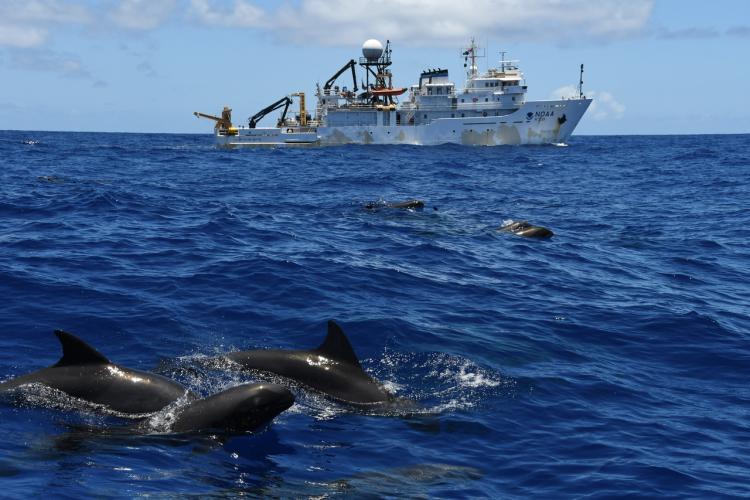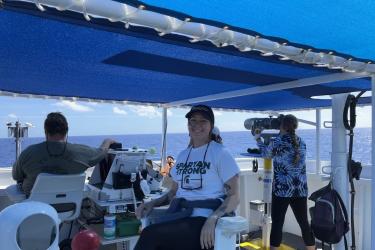Aloha! The 2017 Hawaiian Islands Cetacean and Ecosystem Assessment Survey (HICEAS) is a 187-day survey effort to study cetaceans, seabirds, turtles and their habitat within the U.S. waters of the Hawaiian Islands. This survey effort will occur from July through December aboard two NOAA ships, the Oscar Elton Sette and the Reuben Lasker.
Follow our mission to see what we see as we survey the Pacific Ocean!
Heading to the High Seas

Credit: NOAA Fisheries/Amanda Dillon
On July 6th, 2017, fifteen scientists set sail for the high seas on NOAA Ship Oscar Elton Sette from Ford Island. This six month mission is a collaboration between the Pacific Islands Fisheries Science Center and the Southwest Fisheries Science Center to survey dolphins and whales in the Hawaiian Islands.
Listen Up

Credit: NOAA Fisheries/Kym Yano
We have received the first update from our crew aboard the NOAA Ship Oscar Elton Sette! The scientists are just off of Kona, Hawaii. Members of our acoustics team are listening closely to the calls and clicks of cetaceans.
Turning Plans into Actions

Credit: NOAA Fisheries/Kym Yano
Scientists deployed an acoustic recorder, the Drifting Autonomous Spar Buoy Recorder, that will drift for 3-4 weeks and continuously collect data. Our goals and immense planning are finally becoming reality as the HICEAS team dives into the world of marine science!
Jumping for Joy!
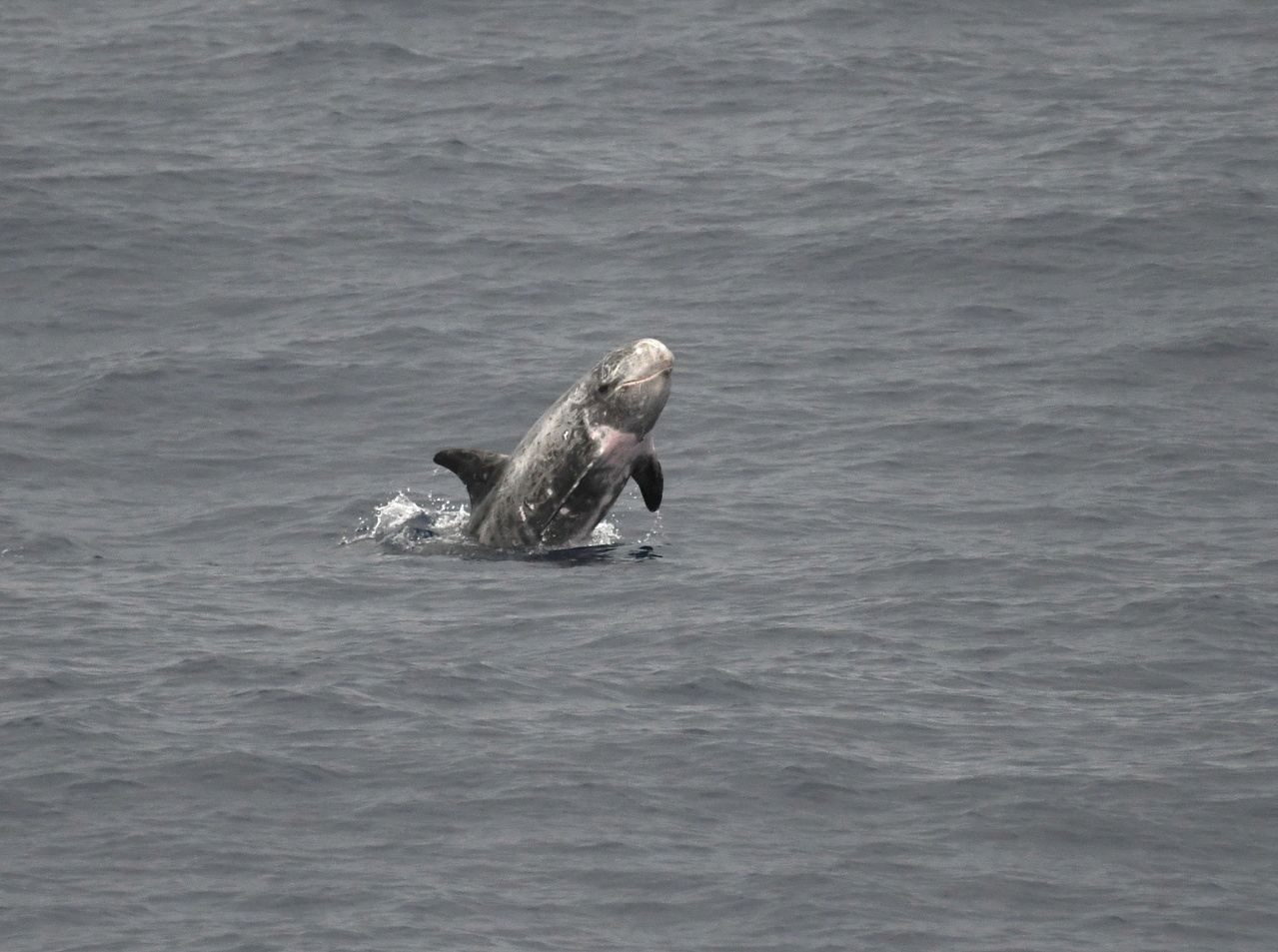
Credit: NOAA Fisheries/Adam Ü (Permit 20311)
A Risso's dolphin (Grampus griseus) leaps during a sighting off the Big Island.
Don't Blink

Credit: NOAA Fisheries/Staci DeSchryver
All hands on deck! The observer team searches for false killer whales, the highest priority species of the project.
A Killer View

Credit: NOAA Fisheries/Adam Ü (Permit 20311)
Even the most experienced observers get excited about killer whales, a species rarely seen in Hawaiian waters. During this sighting, the whales passed about 20 meters away from the stern of our ship, giving everyone a great view before continuing on their way.
The MVP of HICEAS

Credit: NOAA Fisheries/Paula Olson (Permit 20311)
The false killer whale is our top priority species for HICEAS 2017. We have had two sightings in the past week, including this one right after sunrise.
Ready for Lift Off!
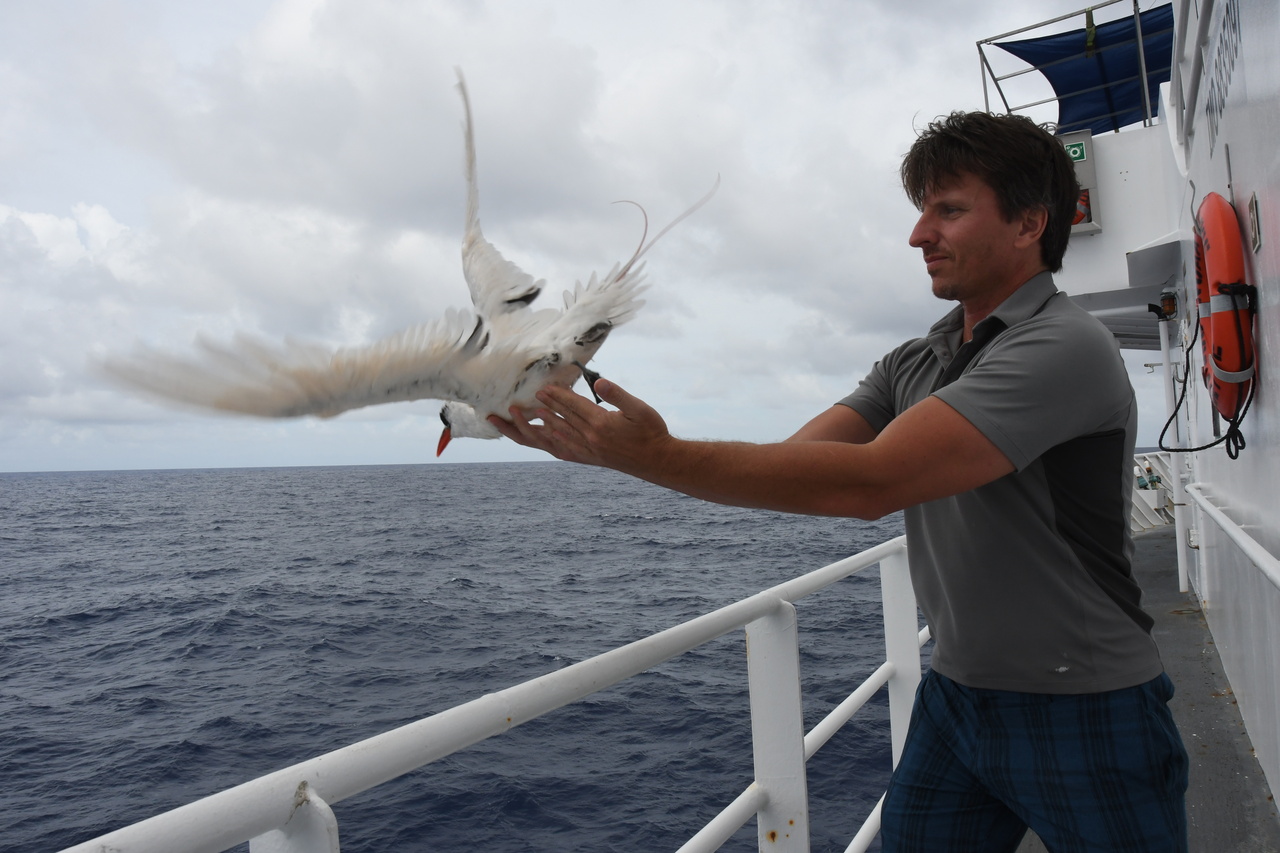
Credit: NOAA Fisheries/Adam Ü (Permit MB033305)
Ornithologist Christopher Hoefer releases a red-tailed tropicbird after it was found on deck.
DASBR Ho!

Credit: NOAA Fisheries/Ali Bayless
The Sette team successfully recovered a DASBR that had been drifting at sea for almost a month recording the sounds of cetaceans. Drifting instruments can become a micro-ecosystem in the pelagic realm, providing substrate for critters like the gooseneck barnacles shown here.
Sonobuoy at Sunset
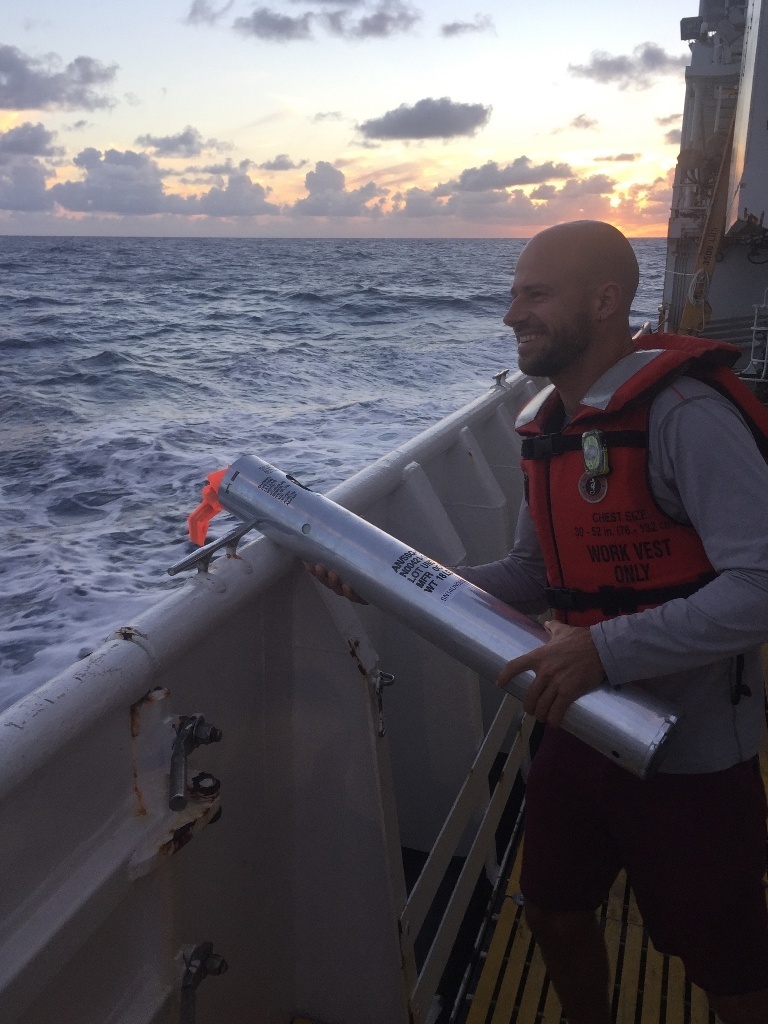
Credit: NOAA Fisheries/Ali Bayless
Visiting scientist Joe Fader from Duke University deploys a sonobuoy at sunset. This short-term drifting buoy contains a hydrophone that detects and transmits the low frequency sounds of baleen whales that might be in the area.
Dorsal Fin Decoding

Credit: NOAA Fisheries/Paula Olson (Permit 20311)
We learn a lot about whales and dolphins from their dorsal fins. The large size of this dorsal fin tells us this short-finned pilot whale is a male. The nicks and notches on the trailing edge of his fin form a unique pattern, much like a fingerprint, which allows us to recognize him if we see him again.
Lasker Sets Sail

Credit: NOAA Fisheries/Seth Sykora-Bodie
The NOAA Ship Reuben Laskeris a 208-ft. research vessel home-ported in San Diego, CA that is used for conducting bottom trawl surveys, protected species assessments, and other oceanographic work. For the next few months, the Laskerand Southwest Fisheries Science Center are partnering with the NOAA Ship Oscar Elton Sette and Pacific Islands Fisheries Science Center to conduct a marine mammal and seabird survey of the entire Hawaiian Islands EEZ.
Sperm Whale Soup

Credit: NOAA Fisheries/Ali Bayless (Permit 20311)
Lead acoustician, Jennifer Keating, communicates with observers on the flying bridge via VHF radio to coordinate the ship’s movements through multiple subgroups of sperm whales. The visual and acoustic teams must work together to get accurate counts of sperm whales and other cetaceans that spend long periods of time at depth.
Chasing Rainbows

Credit: NOAA Fisheries/Ali Bayless (Permit 20311)
Lead acoustician, Jennifer Keating, communicates with observers on the flying bridge via VHF radio to coordinate the ship’s movements through multiple subgroups of sperm whales. The visual and acoustic teams must work together to get accurate counts of sperm whales and other cetaceans that spend long periods of time at depth.
Longman's Luck

Credit: NOAA Fisheries/Adam Ü (Permit 20311)
A large group of Longman’s beaked whales was spotted late in the day, only about 150 nautical miles away from a sighting of a large group of the same species during HICEAS 2010. Could we have found a hotspot for this rare beaked whale?
Late-Night Visitors

Credit: NOAA Fisheries
Three days into the NOAA Ship Reuben Lasker's transit to Hawaii, the acoustics team detected killer whales in the distance. Unfortunately, it was at 10 PM, so everyone had to make do with watching the computer monitor that displays the vocalizations detected by the towed acoustic array.
Back to the Future

Credit: NOAA Fisheries/Amy Van Cise (Permit 20311)
U.S. waters around the Hawaiian Islands extend across the international dateline. We had a chance to “time-travel” on a recent trackline. Much to our surprise and relief, we found that short-finned pilot whales still exist tomorrow, today.
Catch of the Day

Credit: NOAA Fisheries/Christopher Hoefer (Permit MB033305)
An adult red-footed booby, the most common booby species in the Hawaiian Archipelago, catches a flying fish for dinner. These birds capture fish by diving vertically into the water and can dive as deep as 30 meters!
Marine Debris

Credit: NOAA Fisheries/Ali Bayless
The small boat investigated a large pile of marine debris; a mass of derelict fishing gear. Debris like this can create a thriving micro-ecosystem full of life in the middle of the open ocean. Unfortunately, it also poses an entanglement hazard to turtles and marine mammals.
Aerial View

Credit: NOAA Fisheries/Amanda Bradford and Rory Driskell (Permit 20311)
Short-finned pilot whales are highly social and are usually found clustered together. We spotted a group of whales of different ages.
Distinctive Fliers

Credit: NOAA Fisheries/Seth Sykora-Bodie (Permit MB033305)
Out in the middle of the Pacific it can sometimes be difficult to tell various species of shearwaters or petrels apart, but tropicbirds always stand out due to their white coloration and distinctive way of flying.
The 2017 Lunar Eclipse

Credit: NOAA Fisheries/Seth Sykora-Bodie
On August 21st, it was a cloudy day and the Lasker was several thousand miles south of the eclipse’s main path, but the science team took a minute to join the rest of the country watching the solar eclipse.
Curious Eyes in the Sky
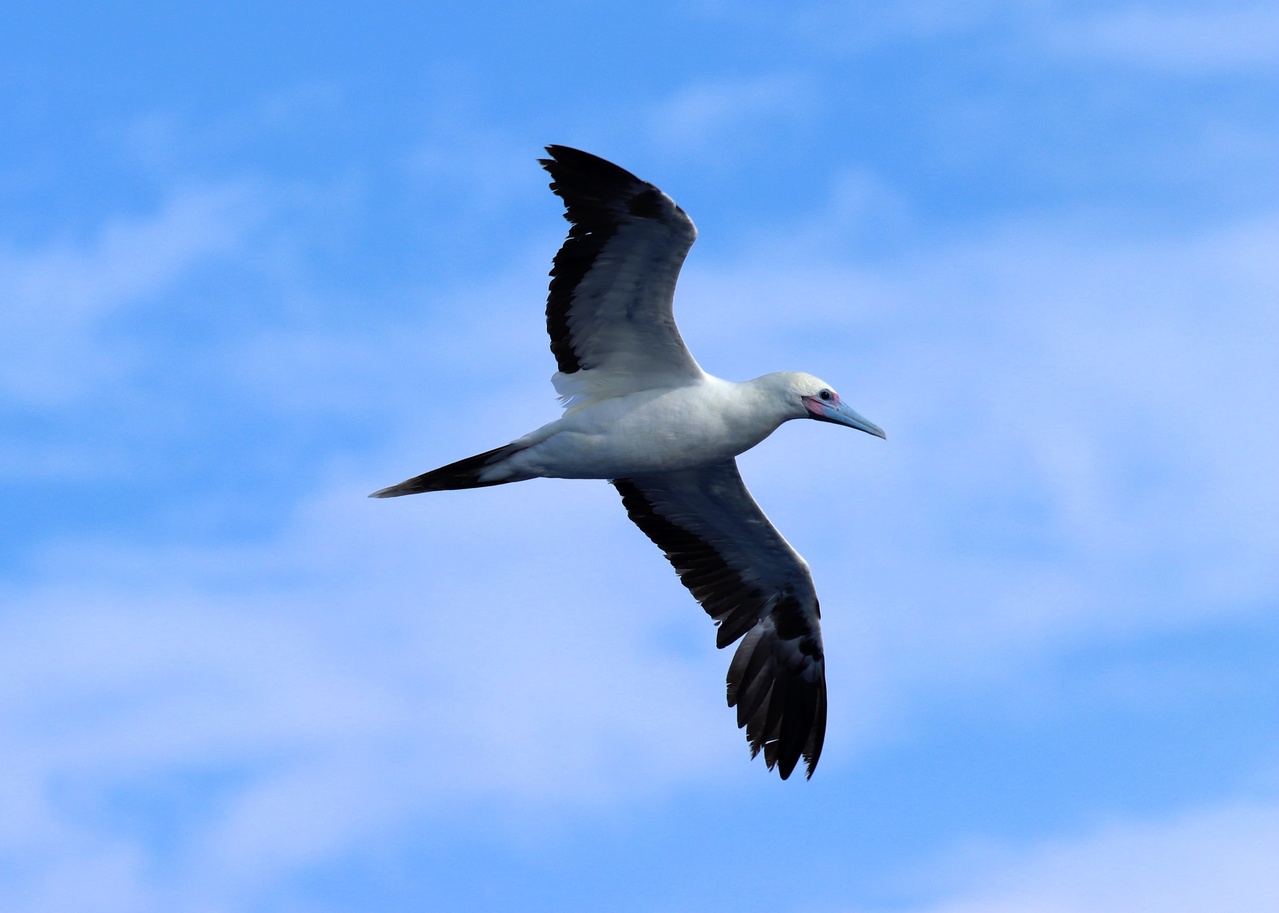
Credit: NOAA Fisheries/Seth Sykora-Bodie (Permit MB033305)
While the bird team kept an eye out for foraging flocks and new species, several red-footed boobies kept an eye on us.
Hawaiian Lava Flow

Credit: NOAA Fisheries/Seth Sykora-Bodie
After spending a long day searching for marine mammals and seabirds, the Lasker’s science team had the chance to slow down and watch a lava flow on the south side of Hawaii.
Stealthy Pseudorcas
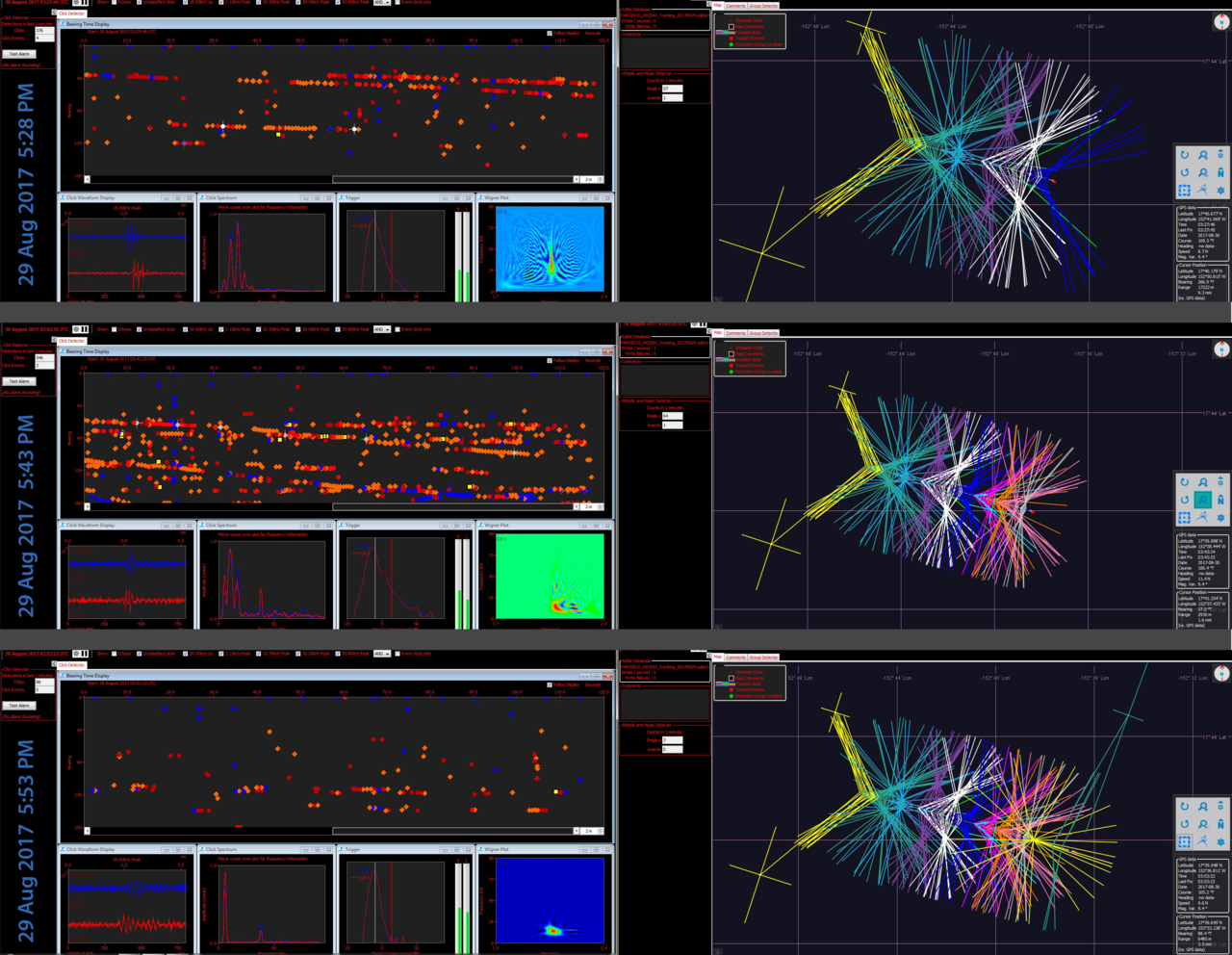
Credit: NOAA Fisheries/Jenny Trickey (Permit 20311)
On August 29th, the Lasker’s acoustics team identified nearly 20 sub-groups of false killer whales, Pseudorca crassidens, but the visual observers were stymied by rough seas that kept them hidden until sunset.
Chilean Visitor

Credit: NOAA Fisheries/Seth Sykora-Bodie (Permit MB033305)
Pictured here is a Juan Fernandez petrel, a type of gadfly petrel that nests on a single island off the coast of Chile and is identified by a black cap, white neck, and dark gray coloration on the upper side of its wings and body.
Our Floating City
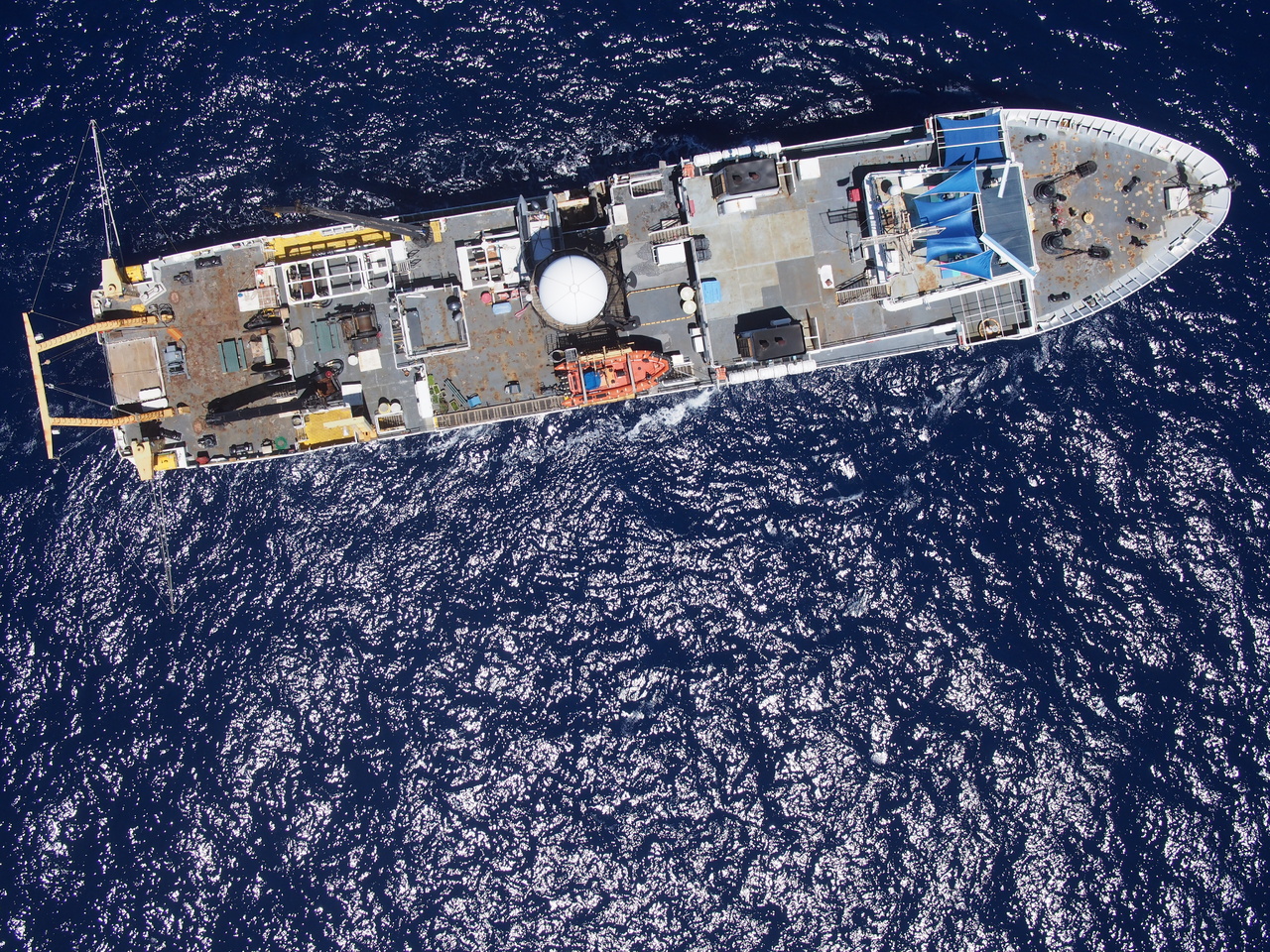
Credit: NOAA Fisheries/Amanda Bradford and Rory Driskell
The NOAA Ship Oscar Elton Sette, previously a submarine hunter during the cold war, was repurposed to seek out and solve the mysteries of the ocean. Here is a bird’s eye view of the Sette, taken with the help of an unmanned aircraft system (UAS), also known as a drone.
Hey There, Stranger!
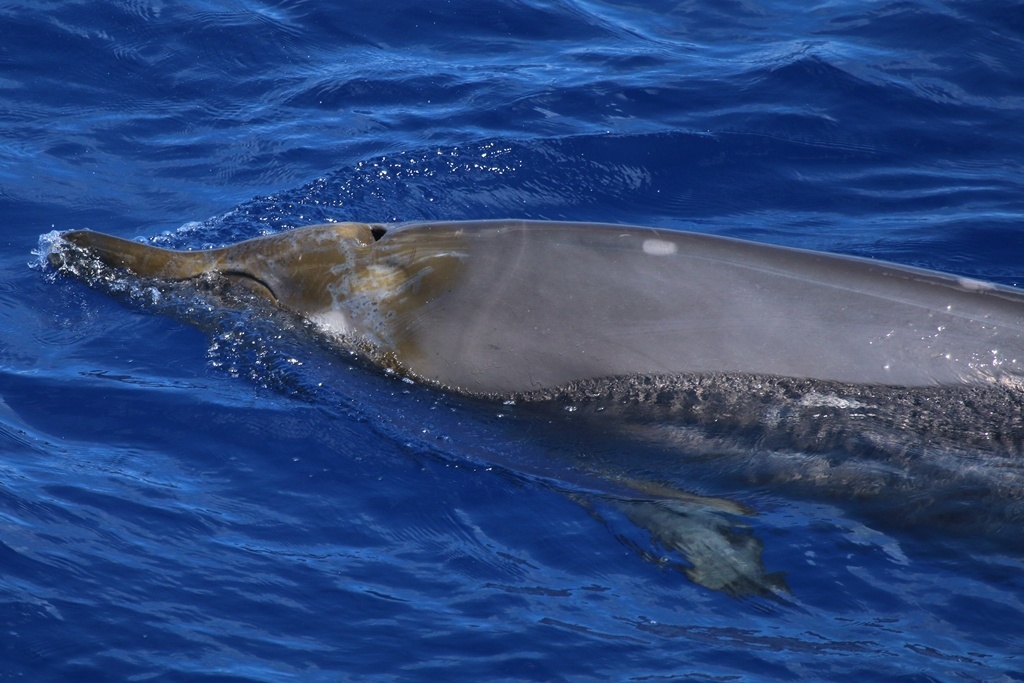
Credit: NOAA Fisheries/Amanda Bradford (Permit 20311)
Blainville’s beaked whales are shy and elusive creatures, and we often only catch a glimpse of them. Today, however, we were lucky enough to have a group of them hang around the ship, seeming as curious about us as we are about them.
Corn Hole

Credit: NOAA Fisheries/Adam Ü
After many moons at sea, when your entire world exists for only 224 feet in any direction, you come up with fun and imaginative ways to pass the time. Here, officers, crew, and scientists socialize and laugh over a round of corn hole, complete with homemade boards and bean bags.
A Rare Look

Credit: NOAA Fisheries/Paula Olson (Permit 20311)
A young Longman’s beaked whale surfaces head-first. These whales were exciting to see since they are so rarely encountered.
Spotted Visitors

Credit: NOAA Fisheries/Amy Van Cise (Permit 20311)
As we move closer to the main Hawaiian Islands, the ship is getting more visits from groups of spotted dolphins. They are not shy, like the mother-calf pair pictured here, and love to play in the wake of the ship’s bow.
HICEAS in Full Force

Credit: NOAA Fisheries/Summer Martin
The Sette and the Lasker pulled into Pearl Harbor on September 5th, which marked a highly anticipated reunion among observers, officers, and crew members. After a quick inport, the collaborative HICEAS team took a photo on September 11th, before both ships sailed away for their next month at sea.
Highest Priority

Credit: NOAA Fisheries/Paula Olson (Permit 20311)
Aboard the Oscar Elton Sette, we started leg 3 with false killer whales–our highest priority species! We will use photos and biopsy samples to determine the population to which they belong (Main Hawaiian Islands, Northwestern Hawaiian Islands, or offshore).
Ever-Present Debris

Credit: NOAA Fisheries/Andrea Bendlin
Two boobies rest atop a mass of nets and line while a huge school of mahi-mahi swim beneath. Marine debris and trash are ever-present in the ocean. NOAA Fisheries and multiple agency partners have conducted surveys and removal of marine debris in the northwestern Hawaiian Islands on a nearly annual basis since 1996. Learn more about the Marine Debris program through the eyes of the 2016 field team at http://arcg.is/1XgKXh3.
Graceful Gliders

Credit: NOAA Fisheries/Christopher Hoefer (Permit MB033305)
The blue-gray noddy (Procelsterna cerulea saxatilis) breeds on Nihoa and Mokumanamana (Necker) with 2,500 and 1,250 breeding pairs, respectively. It stays near its nesting colony year-round. It is a graceful, small seabird that feeds on pelagic waterstriders of the genus Halobates, picking them carefully off the water's surface.
Show Us Your Forehead!

Credit: NOAA Fisheries/Brittany Hancock-Hanser (Permit 20311)
It was a blackfish day on the Reuben Lasker! This morning we sighted false killer whales (Pseudorca crassidens), followed by two sightings of short-finned pilot whales (Globicephala macrorhynchus). The pilot whales paid us a visit, passing close enough to the ship so we could take great photos!
Nothing to See Here

Credit: NOAA Fisheries/Bernardo Alps (Permit MB033305)
Tropicbirds often will come over to inspect vessels at sea. This white-tailed tropicbird (Phaethon lepturus) gave the Lasker a once-over and then continued on its foraging flight.
Island Swimmers

Credit: NOAA Fisheries/Paula Olson (Permit 20311)
Melon-headed whales are often found near oceanic islands. Melon-headed whales are social animals and frequently occur in large groups.
You Lookin' at Me?

Credit: NOAA Fisheries/Adam Ü (Permit MB033305)
A young red-footed booby takes a rest on the Oscar Elton Sette's jackstaff. Does youth always coincide with cuteness and curiosity?
Play Time

Credit: NOAA Fisheries/Christopher Hoefer (Permit 20311)
This sperm whale calf leaps out of the water multiple times over a 10-minute period. We don't know for certain why they do this. Perhaps to remove a parasite such as a remora, or to communicate about its location by making a big splash and loud sound, or maybe just for fun.
Flying Away!

Credit: NOAA Fisheries/Christopher Hoefer
A school of flying squid and a single flying fish scatter as the Oscar Elton Sette passes by.
On the Hunt

Credit: NOAA Fisheries/Andy Bankert (Permit MB033305)
This black-winged petrel was seen chasing a group of flying squid close to the ship one evening. Black-winged petrels breed in the southern Pacific Ocean, but spend their winter north of the equator. The flying squid use propulsion to fly out of the water, likely to avoid predators.
Mahi on Surveillance Duty

Credit: NOAA Fisheries/Bernardo Alps
Many fish species congregate near floating objects in the tropical Pacific Ocean. This beautiful mahi-mahi was hanging out by one of the DASBRs (Drifting Autonomous Spar Buoy Recorders) we recovered.
Magnificent Sperm Whales
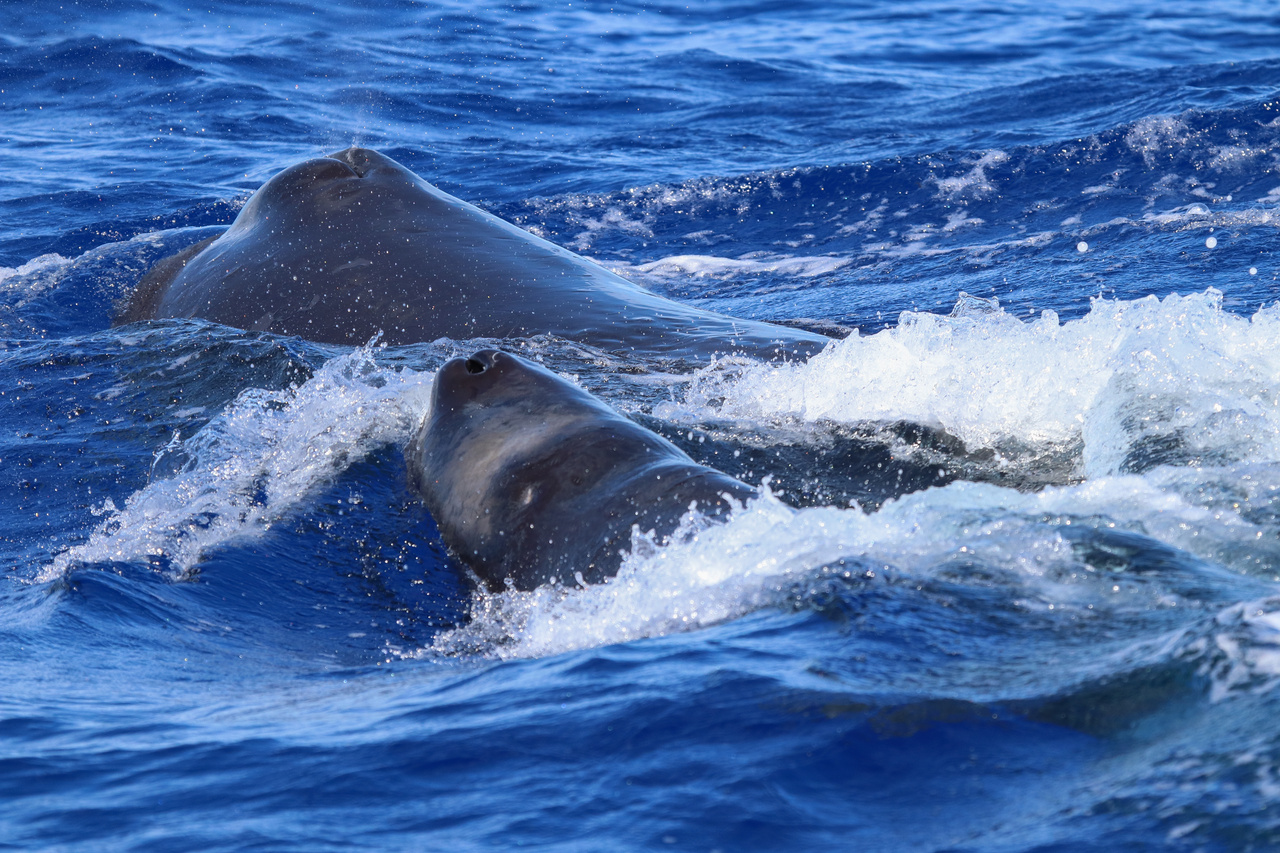
Credit: NOAA Fisheries/Mark Cotter (Permit 20311)
A sperm whale (Physeter macrocephalus) calf swims closely alongside an adult female, likely its mother. These whales were part of a larger cluster exhibiting social behavior over the Akamai seamount.
Fresh Catch!
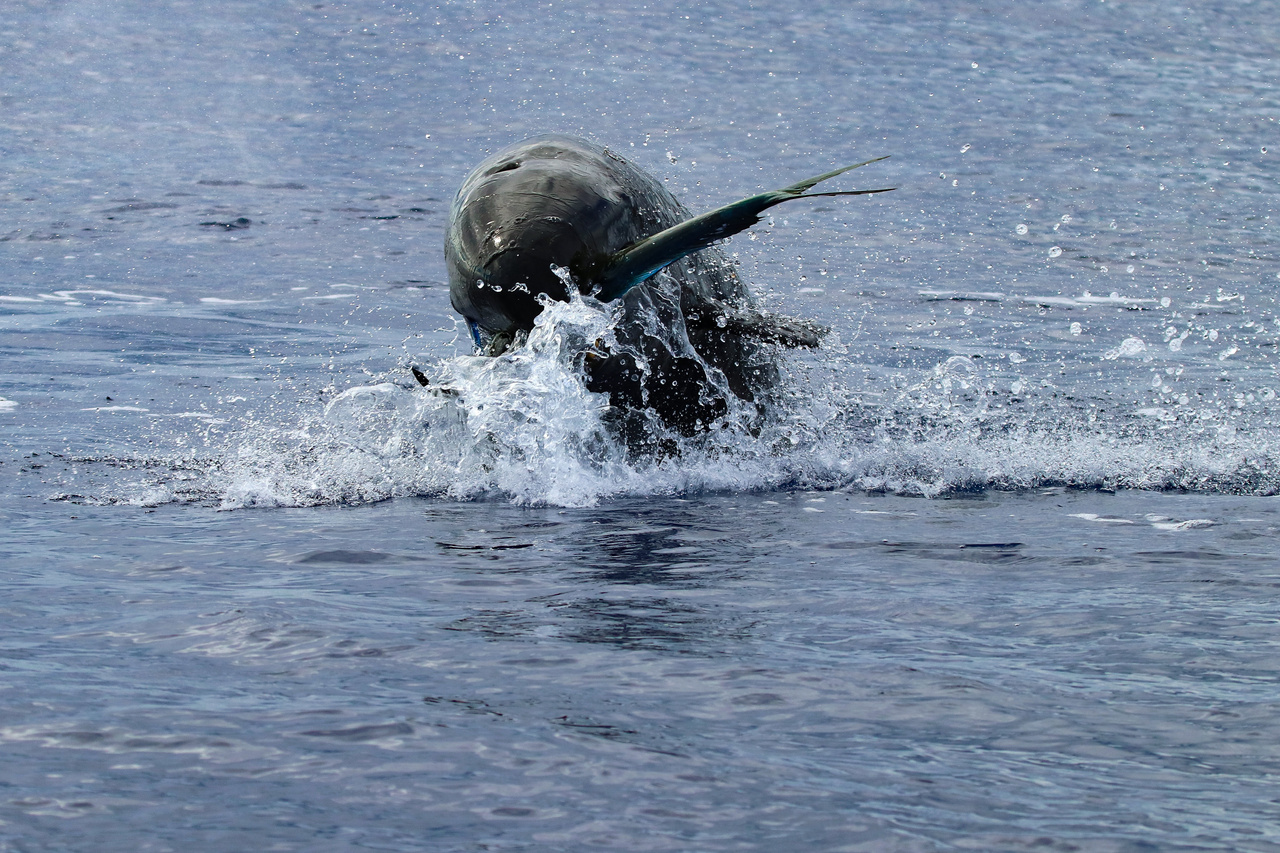
Credit: NOAA Fisheries/Mark Cotter (Permit 20311)
A large false killer whale (Pseudorca crassidens) shows off its mahi-mahi catch as it porpoises from the water. After catching a fish, these whales often engage in leaping and social behaviors before sharing the bounty with each other.
Always Avoid the Bitey End

Credit: NOAA Fisheries/Marie Hill
The in-line array was attacked overnight by a cookie cutter shark (1; Photo: NOAA Fisheries/Jessica Chen) that left a gash in the rubber tubing about the size of a quarter (2-3) causing the castor oil inside to gush out. The tube was fully drained of oil to make sure that saltwater didn't do any damage (2). The tube had to be replaced and was removed, leaving the "guts" of the array on the table (4). Jennifer Keating soldered the wires back to the connector (5) and tested to make sure that the connections were good (6). Jennifer and Erik Norris refilled the new tube with castor oil (7) and the fully repaired array was redeployed (8); all before lunch!
Just a Typical Day on Kure

Credit: NOAA Fisheries/Christopher Hoefer
Monk seals nap on Green Island at Kure Atoll. They are surrounded by marine debris, which washes ashore on many of the beaches within the Papahānaumokuākea Marine National Monument. The islands act as magnets for debris floating in the ocean. Everything from boats to slippers can be found.
Enroute to the Main Hawaiian Islands

Credit: NOAA Fisheries/Adam Ü (Permit 20311)
Humpback whales have arrived in the Northwestern Hawaiian Islands! We saw the first juvenile humpback off Kure on September 26 and this juvenile humpback off Pearl and Hermes on September 28.
Welcome to Tern Island!

Credit: NOAA Fisheries/Christopher Hoefer (Permit MB033305)
French Frigate Shoals (Kānemiloha‘i) is the largest atoll in the Northwestern Hawaiian Islands (232,000 acres). Tern Island, a part of the atoll, was made into a runway during World War II and was used as a fueling stop for military planes flying to Midway. Today it is the location of the base camp for monk seal and turtle researchers during May to October.
Birds on Tern

Credit: NOAA Fisheries/Christopher Hoefer (Permit MB033305)
Tern Island is a bird rookery where frigate birds, red-footed boobies, masked boobies, brown boobies, brown and black noddies, sooty and white terns, and wedge-tailed shearwaters were seen nesting during our visit.
Picking Up Tern Island Campers

Credit: NOAA Fisheries/Greg Sanders
The Sette's deck crew and PIFSC scientists work together to remove all monk seal and turtle camp supplies from Tern Island. A small boat was launched from the ship and made multiple trips over the period of a day and a half. Buckets of gear are lifted onto the ship by a simple line (rope) and cargo hook.
Whale Shark!

Credit: NOAA Fisheries/Bernardo Alps
At approximately 3 meters (~10 feet) in length, this whale shark is just a youngster; this species can grow to over 12 meters long! This picture was taken on Leg 2, during one of three encounters between the NOAA ship Reuben Lasker and the largest fish on Earth.
Beautiful Acrobats

Credit: NOAA Fisheries/Bernardo Alps (Permit 20311)
A pantropical spotted dolphin arches high out of the water, probably to take a good look at the NOAA ship Reuben Lasker, during an encounter near Molokai.
Up Close and Personal

Credit: NOAA Fisheries/Arial Brewer (Permit 20311)
Like many dolphin species, false killer whales like to bow-ride, a behavior where the animals let the pressure wave in front of a ship help push them along.
A Common Visitor...or Is It?

Credit: NOAA Fisheries/Bernardo Alps (Permit MB033305)
Observers from the NOAA ship Reuben Lasker have seen red-footed boobies regularly; they like to hang around and catch flying fish flushed out of the water by the approaching vessel. This white-morph individual has a dark tail, indicating that it is the subspecies websteri, commonly found off Central and South America, rather than the subspecies rubbripes, which is expected around the Hawaiian archipelago.
Eye-Catching Orange

Credit: NOAA Fisheries/Bernardo Alps (Permit MB033305)
Although superficially similar to the more common masked booby, this bird has an orange rather than a yellow bill, indicating it is a Nazca booby. This species breeds on the Galapagos Islands and off Central America. As far as we could determine, this is only the sixth record in Hawaii.
Floating Treasure

Credit: NOAA Fisheries/Bernardo Alps
Unfortunately, we find many man-made objects floating in the waters of the Hawaiian Islands EEZ, but we get excited when we spot a Japanese glass fishing float like this one. This kind of float is no longer used in fishing, but there are still some carried by the currents in the North Pacific Ocean.
Leaping Fraser's Dolphins

Credit: NOAA Fisheries/Paula Olson (Permit 20311)
October 21st marked the third encounter with Fraser’s dolphins for HICEAS 2017, and it was exciting to see these rare dolphins. Beautiful Fraser's dolphins are a treat to watch and often leap out of the water in a coordinated, "chorus-line" manner.
A Beaufort 7 Sort of Day!

Credit: NOAA Fisheries/Lauren Jacobsen
On October 23rd, the NOAA ship Reuben Lasker trekked through Beaufort 7 conditions, with 12-foot swells and 30-knot winds. These swell and weather conditions are not conducive for visual or acoustic detections, but instead result in a “weather watch” where one observer monitors the weather for improved conditions in hopes of resuming search effort.
Diving Deep

Credit: NOAA Fisheries/Bernardo Alps (Permit 20311)
A female sperm whale lifts her flukes high at the beginning of a deep dive. Sperm whales are among the cetacean species most often encountered in deep waters around the Hawaiian archipelago.
Pygmy Sperm Whale

Credit: NOAA Fisheries/Mark Cotter (Permit 20311)
A rare photo of a pygmy sperm whale (Kogia breviceps). Pygmy sperm whales are hard to photograph because they are difficult to spot at sea and avoid vessels. They are typically found alone or in pairs, and moves inconspicuously by rising to the surface and dropping back underwater with little splash.
Left Wing Graze
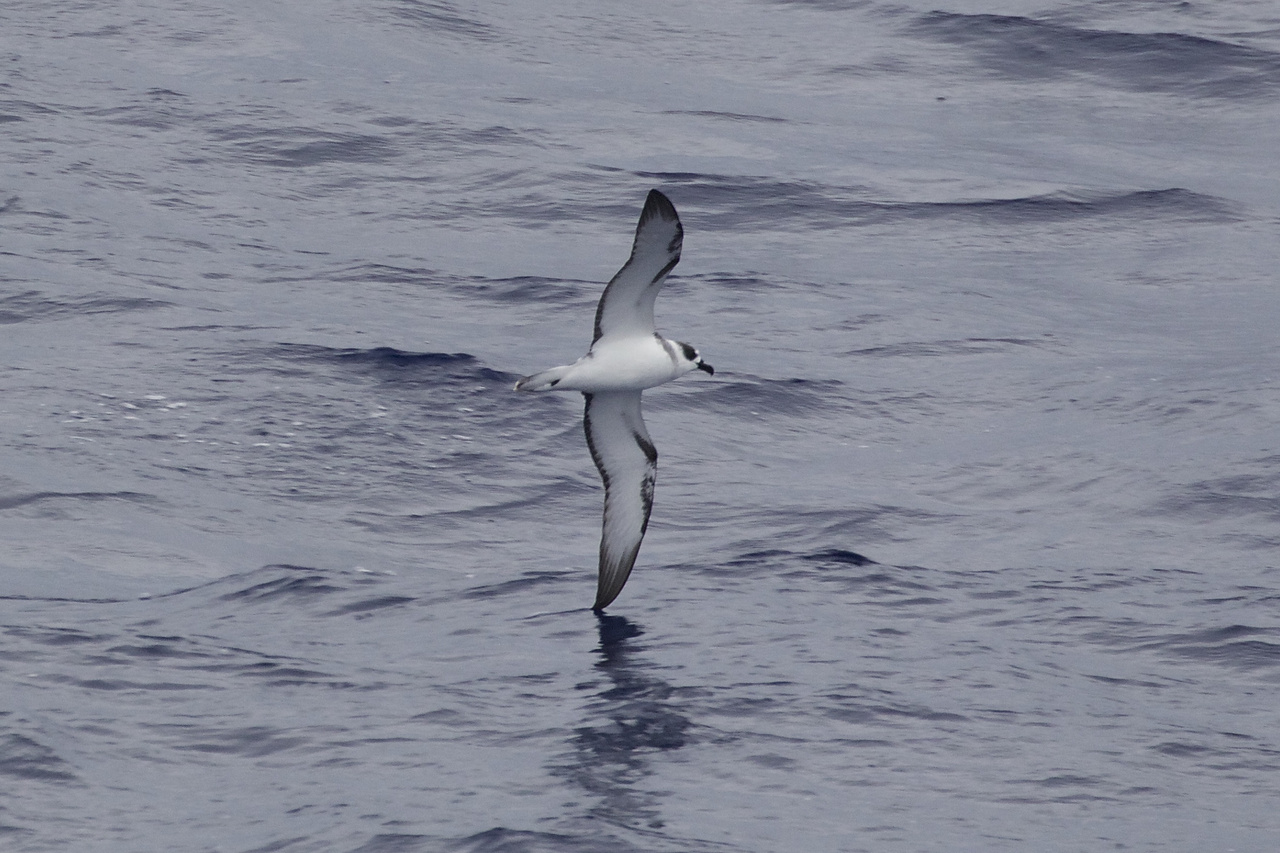
Credit: NOAA Fisheries/Michael Force (Permit MB033305)
Whether or not a day at sea is lucky to include a cetacean sighting, various species of birds are seen from the ship. On this day, this gorgeous white-necked petrel was photographed from the ship as its left wing grazes the water.
Coming Up for Air

Credit: NOAA Fisheries/Bernardo Alps (Permit 20311)
On November 8, the last survey day of Lasker's leg 3 before the ship headed back to Honolulu, a group of rough-toothed dolphins enjoyed the ship's waves.
Pseudorca Surfer
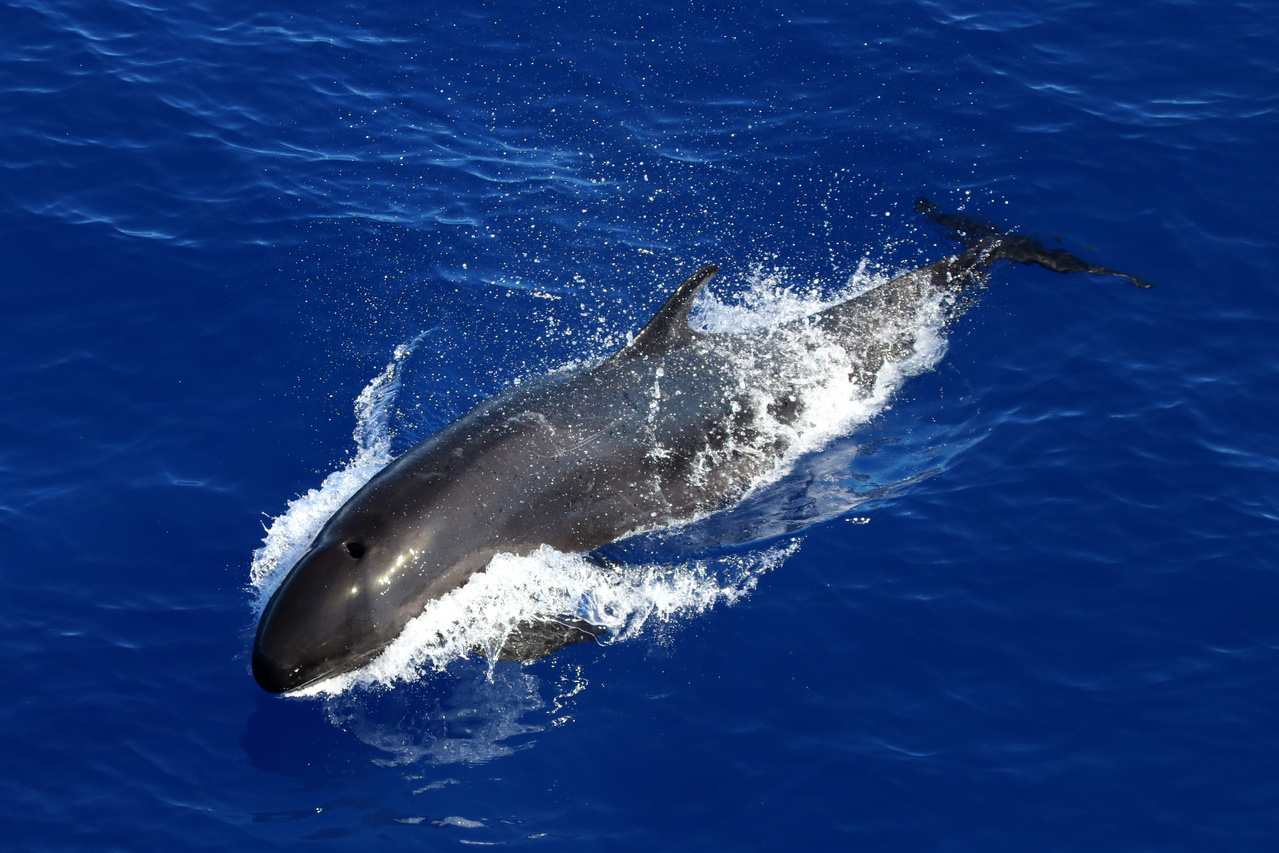
Credit: NOAA Fisheries/Charlotte Boyd (Permit 20311)
On November 17, we encountered a large dispersed group of false killer whales - the ship was surrounded by some unknown number of subgroups. In addition to sightings from the ship, we launched the small boat and collected three biopsies and close photographs for individual identification.
Majestic Backdrop

Credit: NOAA Fisheries/Bernardo Alps (Permit MB033305)
Black-footed albatrosses nest on the Northwestern Hawaiian Islands, but feed mainly in the Gulf of Alaska and the California Currents, where they learn to follow ships and feed on discards from fisheries and trash. This individual was probably following the NOAA ship Reuben Lasker hoping for a similar feeding opportunity.
Keep Your Eyes on It
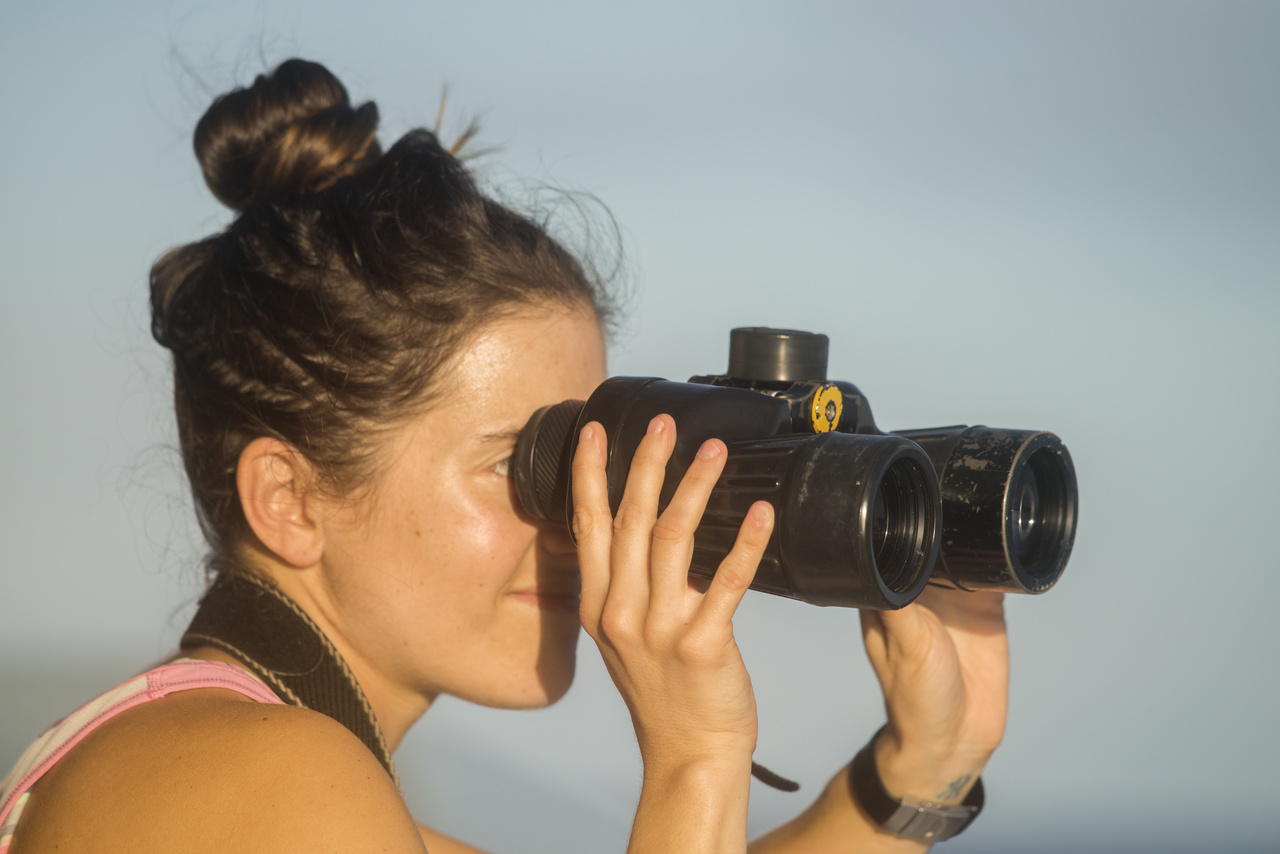
Credit: NOAA Fisheries/Bernardo Alps
Visiting Scientist Elizabeth Hetherington works on getting a size estimate of a pod of pantropical spotted dolphins from the flying bridge of the NOAA ship Reuben Lasker. Observers write down their group size estimates without consulting with each other to avoid any possible bias.
Thanksgiving Festivities at Sea

Credit: NOAA Fisheries/Bernardo Alps
Crew, officers, and scientist have a Thanksgiving dinner far from home but in the company of friends. The mess hall of the ship was decorated for the occasion and the dinner included turkey and all the trimmings.
Deploy. Retrieve. Repeat.

Credit: NOAA Fisheries/Bernardo Alps
Acoustician Jennifer Keating retrieves the acoustic array at the end of the day on the fantail of the NOAA ship Reuben Lasker. The array contains a set of specialized hydrophones (underwater microphones) and is responsible for many detections of marine mammals. It is retrieved and deployed multiple times per day for various reasons, such as before every CTD cast (conducted twice per day), during rough weather conditions, prior to small boat launches, and to conduct acoustic array maintenance.
Artistic Effect

Credit: NOAA Fisheries/Bernardo Alps (Permit 20311)
A rough-toothed dolphin appears distorted like a modernist painting, caused by the refraction on the surface of the water as the dolphin rides the bow of the NOAA ship Reuben Lasker. When ships and boats move through the water, they create a pressure wave that pushes dolphins along, much like a surfer rides an ocean wave near the beach.
